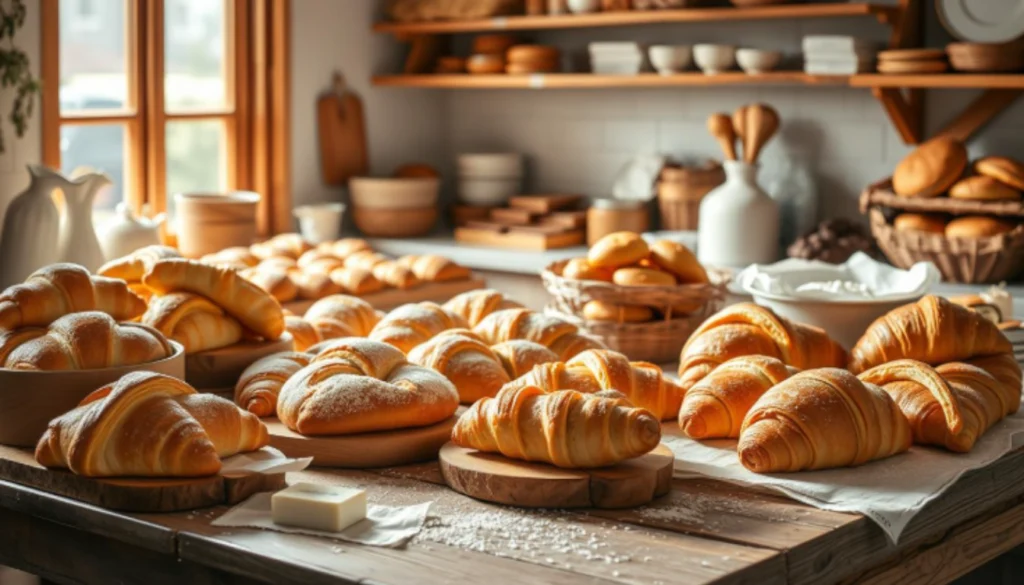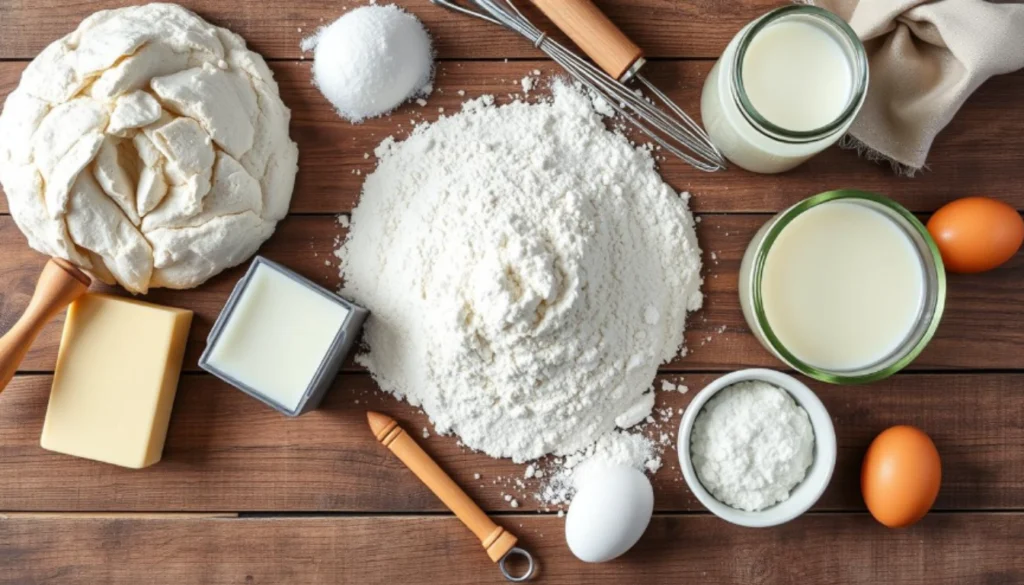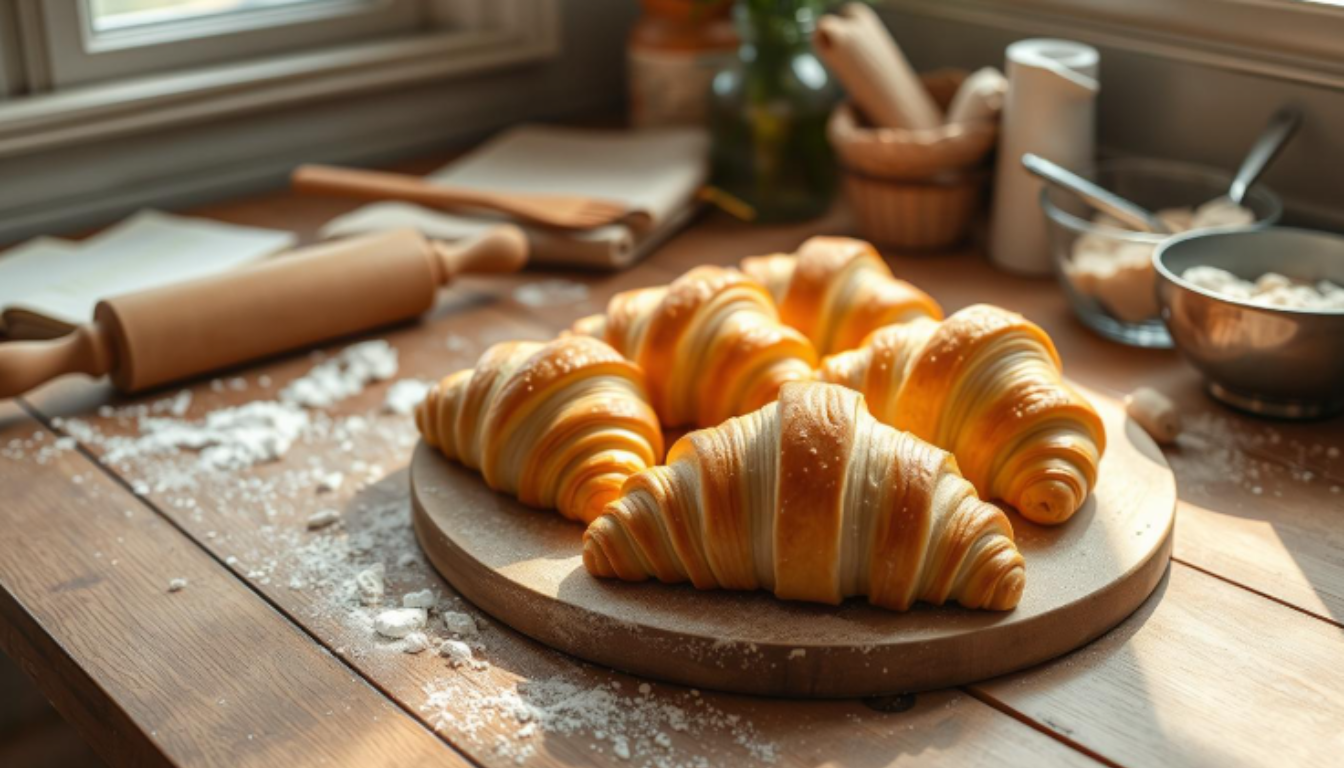Imagine starting your day with the perfect recipe for Swiss Gipfeli croissants. Known for their delicate, buttery layers, these Swiss croissants are a beloved breakfast treat in Switzerland. With this recipe, you will learn how to make gipfeli recipe croissants at home, so you can enjoy the taste of a traditional Swiss bakery right in your kitchen.
Table of Contents
Understanding Swiss Gipfeli Recipe: A Traditional Breakfast Delicacy
Gipfeli is a beloved Swiss breakfast pastry. It holds a special place in the Alpine nation’s hearts and traditions. Let’s dive into its rich history and what makes it different from the French croissant.
The History of the Classic Gipfeli Recipe in Swiss Culture
The gipfeli’s origins date back to the 19th century. Swiss bakers mastered laminated dough, creating a flaky, buttery pastry. This pastry has become a key part of Swiss culture, enjoyed at breakfast and in cafes.
How the Swiss Gipfeli Recipe Differs from French Croissants
At first glance, gipfeli and French croissants look similar. But they have key differences. The gipfeli is more crescent-shaped and has a chewier texture. It also has a stronger butter flavor, thanks to Swiss baking techniques.
The Cultural Significance of Swiss Gipfeli Pastries
In Switzerland, enjoying a warm gipfeli with coffee or tea is a cherished morning ritual. These pastries are more than breakfast; they’re a cultural tradition.

Essential Ingredients for an Authentic Gipfeli Recipe
To make the perfect Swiss pastry baking treat, gipfeli, you need top-notch european bakery items. You’ll need quality butter and the finest flour.
Pair the butter with high-protein bread flour. This flour gives your gipfeli structure and chewiness. It’s what makes them traditional.
- Premium European-style butter with a high fat content
- High-protein bread flour for structure and chewiness
- Active dry yeast to achieve the perfect rise and airiness
- Granulated sugar to balance the savory flavors
- Kosher salt to enhance the overall taste profile
Remember the active dry yeast. It makes your gipfeli airy and flaky. A bit of granulated sugar and kosher salt add to the flavor. They create a perfect balance.
With these ingredients, you’re set to master pastry baking. You can now bring a taste of Switzerland into your kitchen.

Tools and Equipment You’ll Need for Baking the Perfect Gipfeli Recipe
To bake the perfect flaky viennoiserie, like the Swiss gipfeli, you need more than ingredients. You’ll need the right tools and equipment to make sure your pastries look great every time. Here are the must-have items and some optional accessories for mastering gipfeli baking.
Must-Have Baking Tools for Gipfeli Pastries
- A sturdy rolling pin for shaping and rolling out the dough
- A sharp chef’s knife or bench scraper for cutting the dough
- A pastry brush for applying egg wash or glazes
- A baking sheet or French bread pan for shaping gipfeli
- A digital food thermometer to check dough and oven temperatures
Optional Equipment for Professional Gipfeli Results
While the basic tools are essential, you might also want these optional items for better gipfeli baking:
- A stand mixer with a dough hook for easy kneading
- A pastry board or silicone baking mat for a smooth surface
- A dough docker or dough scraper to avoid air pockets and ensure even lamination
- A spray bottle for misting the dough during proofing and baking
Temperature and Environment Tips for the Best Gipfeli Recipe
Keeping the right temperature and environment is key for perfect flaky viennoiserie. The dough and baking area should be cool, between 60-65°F (15-18°C), to prevent butter from melting too fast. Also, preheat the oven to 400-425°F (200-220°C) for even rising and browning.
Master Gipfeli Recipe: Step-by-Step Instructions
Making your own croissants, or Swiss gipfeli, is a delightful and satisfying experience. This guide will help you make flaky, buttery gipfeli that are as good as those from Swiss bakeries. Let’s start and learn how to make your own delicious swiss croissant recipe.
Gather Your Ingredients for the Gipfeli Recipe
Ingredients: 🥐✨
For the Dough:
🍞 4 cups all-purpose flour
🥄 2 tbsp granulated sugar
🧂 1 tsp salt
🥛 1 cup warm milk
🥚 1 large egg
🧈 1 ¼ cups unsalted butter, cold and cubed
🥄 2 ¼ tsp active dry yeast
For the Glaze:
🥚 1 large egg, beaten
🥄 1 tbsp milk
Steps:
1️⃣ Activate the Yeast: In a small bowl, mix warm milk and yeast. Let it sit for 5 minutes until foamy.
2️⃣ Make the Dough: In a large bowl, combine flour, sugar, and salt. Add the yeast mixture and the egg. Mix until a dough forms, then knead until smooth and elastic, about 8 minutes. Cover and refrigerate for 1 hour.
3️⃣ Incorporate Butter: Roll out the dough into a large rectangle. Spread cold butter cubes evenly over two-thirds of the dough. Fold the unbuttered third over the middle, then fold the other side over it, like a letter. Roll out gently, cover, and chill for 30 minutes.
4️⃣ Laminate the Dough: Repeat the rolling and folding process 3 more times, chilling the dough for 30 minutes between each fold.
5️⃣ Shape the Gipfeli: Roll the dough into a large rectangle, about ¼-inch thick. Cut into triangles. Starting from the base, roll each triangle tightly toward the tip to form a crescent shape.
6️⃣ Proof the Gipfeli: Place the shaped dough on a baking sheet lined with parchment paper. Cover and let rise in a warm place for 45–60 minutes.
7️⃣ Bake: Preheat your oven to 400°F (200°C). Brush the Gipfeli with the egg wash. Bake for 15–20 minutes, or until golden brown.
8️⃣ Cool & Serve: Let them cool slightly before serving. Pair with butter, jam, or enjoy as-is!
Check out this guide to see more creative recipes
The Art of Laminating Dough for a Flaky Gipfeli Recipe
Mastering laminating dough is key to making flaky, buttery viennoiserie treats like Swiss gipfeli. This process of layering butter and dough makes traditional croissants stand out.
Creating Perfect Butter Layers
The base of a great laminated dough is in the butter layers. The butter must be spread evenly, with dough in between each layer. This makes gipfeli and other viennoiserie so tempting. Getting the butter just right is key for perfect lamination.
Common Lamination Mistakes to Avoid
- Overworking the dough, which can result in tough and dense pastries
- Improper temperature control, leading to butter leakage or dough tearing
- Failing to chill the dough thoroughly between folds, causing the butter to melt
- Applying too much or too little pressure during the folding process
Timing and Temperature Control
For perfect gipfeli, timing and temperature are crucial. The dough needs to chill just right between folds. This keeps the butter firm and the layers intact. The right oven temperature and baking time are also key for those flaky, golden pastries.”
Shaping Techniques for Classic Swiss Gipfeli Recipes
Making the perfect Swiss bakery treats is an art. Shaping the classic Swiss gipfeli is key. It needs a special touch to get the crescent shape and flaky texture. We’ll show you how to shape your gipfeli like a pro.
Rolling and Cutting the Dough
Start by rolling out the chilled dough into a long rectangle, about 1/4 inch thick. Use a sharp knife or pizza cutter to cut the dough into triangular pieces. Each triangle should have a wide base of about 4 inches for even sizes.
Forming the Crescent Shape
- Gently stretch each triangle to make a longer, more defined crescent shape.
- Roll the dough from the wide base to the pointed tip to get the classic crescent form.
- Pinch the pointed tip to seal the roll, keeping its shape during baking.
Remember, handling the dough gently is crucial. Overworking it can make the pastries tough. So, be careful with your technique.
By following these steps, you’ll make authentic Swiss gipfeli. They’ll impress your friends and family. So, let’s get shaping and bake some Swiss delights!
Proofing and Baking Guidelines for Gipfeli Pastries
To make perfect Swiss gipfeli, or croissants, you need to focus on proofing and baking. Proper proofing makes the dough light and airy. The right baking temperature and time give a golden, flaky crust that’s irresistible.
Signs of Proper Proofing
Proofing is key in making the dough rise before baking. The dough should double in size and look puffed and shiny. If you press it gently and it springs back fast, it’s ready.
But, if it’s too puffed, it’s overproofed. If it’s dense, it’s not ready yet.
Optimal Baking Temperatures and Times
For the best pastry baking, heat your oven to 400°F (200°C). Place the dough on a baking sheet lined with parchment paper, leaving space for even rising. Bake for 15-20 minutes, flipping the pan halfway, until they’re golden.
The secret to a good croissant is keeping the oven at the right temperature and baking for the right time. This ensures flaky layers and a soft, buttery inside.
By following these steps, you’ll make authentic Swiss gipfeli at home. With practice, you’ll impress everyone with your pastry baking skills. Enjoy making these tasty Swiss breakfast pastries for your loved ones.
Creative Variations and Specialty Gipfeli Recipes
The traditional Swiss gipfeli is a treat, but there are many tasty variations. From sweet to savory, these specialty gipfeli recipes will excite your taste buds.
The nussgipfel, or nut-filled gipfeli, is a favorite. These croissants are filled with a creamy, nutty mix. The flaky dough and the nutty center make for a luxurious treat.
For those who love sweets, try making schokoladengipfel, or chocolate-filled gipfeli. They have a layer of rich chocolate inside the dough. This mix of textures and flavors is a delight.
For a savory option, try käsegipfel, filled with cheese. The melted cheese inside is comforting and satisfying.
You can also make unique shapes with your gipfeli dough. From elegant twists to intricate braids, the presentation can be as creative as the filling.
“What makes gipfeli so lovely is the simplicity and care that go into its creation. Every version demonstrates the talent and inventiveness of the Swiss bakers who have mastered this classic treat.”
Whether you’re an experienced baker or new to gipfeli-making, these recipes are a fun way to explore. They bring a bit of Swiss charm to your kitchen.
Creative Variations and Specialty Gipfeli Recipes
Keeping your homemade buttery breakfast buns fresh is key. These classic Swiss bakery treats are best enjoyed when fresh. Here are some easy tips to keep your gipfeli tasty and soft.
Maintaining Freshness
Your gipfeli should be kept at room temperature in an airtight container. Don’t store them in the refrigerator. They may get stale from the cold air. To get the finest flavor, eat them within two to three days.
Freezing and Thawing Techniques
Freezing is great for leftover gipfeli or making them ahead. Cool the pastries and freeze them on a baking sheet. Then, put them in a container or bag for up to 2 months.
Allow them to defrost for 30 to 60 minutes at room temperature. Or, warm them in a 300°F oven for 5-10 minutes. This will make them crispy again.
Storing and reheating right is crucial. It keeps your buttery breakfast buns and Swiss bakery treats delicious. With a bit of care, enjoy fresh gipfeli whenever you want.
Explore more decadent dessert ideas on our homepage.
Conclusion
Creating authentic Swiss gipfeli in your kitchen is rewarding. It involves mastering laminating dough and perfecting shaping. This way, you can enjoy the flaky, buttery goodness of these Swiss croissants.
Whether you stick to the classic gipfeli recipe or try new variations, making these pastries is special. As you get better at baking, remember to enjoy the journey. Pay attention to details and savor each bite of your homemade traditional Swiss baking.
We hope this guide helps you bring Switzerland’s taste to your home. Enjoy the fruits of your labor. Let the aroma of freshly baked gipfeli fill your kitchen and delight your senses. Happy baking!
FAQ
What is the difference between a gipfeli and a croissant?
Gipfeli, also known as Swiss croissants, are a special version of the French croissant. They look similar but are smaller and more crescent-shaped. Gipfeli also have a unique flavor that shows the Swiss baking tradition.
What are the key ingredients for making authentic gipfeli?
To make gipfeli, you need high-quality butter, all-purpose flour, yeast, and a bit of salt. The right mix and quality of these ingredients are key for the perfect Swiss pastry.
What is the secret to making a good croissant or gipfeli?
The secret to great croissants or gipfeli is the lamination process. It’s important to layer the dough with butter right. Also, keeping the right temperature and technique during lamination and proofing is crucial for success.
What are some common mistakes to avoid when making croissants or gipfeli?
One big mistake is overworking the dough, which makes it tough. Not controlling the temperature and environment during lamination and proofing can also cause problems. It’s important to follow the recipe and techniques closely for perfect gipfeli.
What is a nussgipfel?
A nussgipfel is a Swiss version of the gipfeli with a nut-filled center. It has a flaky, buttery outside and a rich nut filling, often hazelnuts or almonds. Nussgipfel are a favorite in Swiss bakeries and a tasty twist on the classic gipfeli.


1 thought on “Gipfeli Recipe: How to Make Perfect Swiss Croissants at Home”